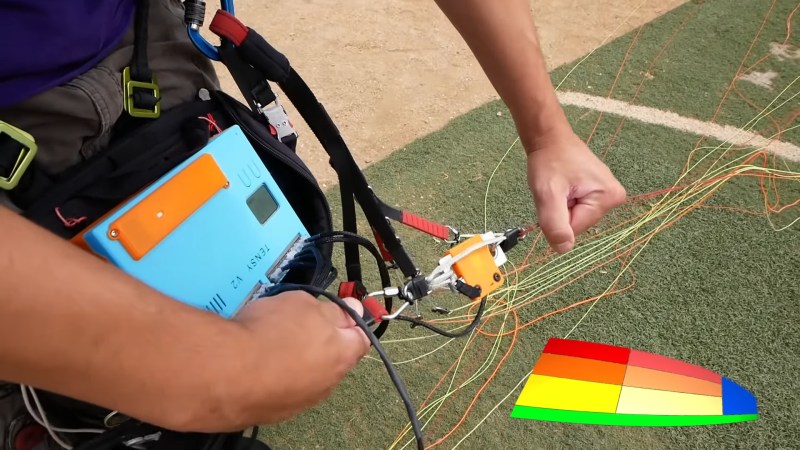No matter what they’re flying, good pilots have a “feel” for their aircraft. They know instantly when something is wrong, whether by hearing a strange sound or a feeling a telltale vibration. Developing this sixth sense is sometimes critical to the goal of keeping the number of takeoff equal to the number of landings.
The same thing goes for non-traditional aircraft, like paragliders, where the penalty for failure is just as high. Staying out of trouble aloft is the idea behind this paraglider line tension monitor designed by pilot [Andre Bandarra]. Paragliders, along with their powered cousins paramotors, look somewhat like parachutes but are actually best described as an inflatable wing. The wing maintains its shape by being pressurized by air coming through openings in the leading edge. If the pilot doesn’t maintain the correct angle of attack, the wing can depressurize and collapse, with sometimes dire results.
Luckily, most pilots eventually develop a feel for collapse, sensed through changes in the tension of the lines connecting the wing to his or her harness. [Andre]’s “Tensy” — with the obligatory “McTenseface” surname — that’s featured in the video below uses an array of strain gauges to watch to the telltale release of tension in the lines for the leading edge of the wing, sounding an audible alarm. As a bonus, Tensy captures line tension data from across the wing, which can be used to monitor the performance of both the aircraft and the pilot.
There are a lot of great design elements here, but for our money, we found the lightweight homebrew strain gauges to be the real gem of this design. This isn’t the first time [Andre] has flown onto these pages, either — his giant RC paraglider was a big hit back in January.
Thanks to [mip] for the tip.

















The number of landings is ALWAYS the same as the number of takeoffs. The objective is to make the number of GOOD landings (i.e., landings you can walk away from) or even GREAT landings (landings you can fly away from) the same as the number of takeoffs.
I think it’s fair to say given the context that a landing is being treated as distinct from a crash.
You mean a “crash landing”? It’s still a landing. Another popular pilot saying: takeoffs are optional; landings are mandatory.
Or… a crash is an uncontrolled landing, whereas a landing is a controlled crash.
At some point it just stops being a landing and starts being a crash.
It’s also very hard to make a landing in a paraglider where the wing itself can’t be reused but you can still walk away. It’s rather easy to have landings where you won’t be walking away (or ever again) but still be able to use the parachute.
personally I prefer flying something that won’t collapse on entering a good thermal or when encountering the wrong gust of wind.
Very true. I am more familiar with High Powered Rocketry but similar concepts apply.
The rocket always comes down, it is just the factor of the braking technique that determines the success or failure of the flight.
We generally deal with two approaches; controlled descent vs lithobraking
Controlled descent is what most people go for. You are using parachutes or other aerodynamic features to control the return to the ground resulting in a gentile stop at the end.
Lithobraking is a bit more of an advanced concept. It is using the rigid outer part of the earth, consisting of the crust and upper mantle, for rapid deceleration. If done improperly, this can be a violent end to the rocket. Most people try to avoid this.
To be pedantic, this appears to use commercial strain gauges in custom load cells.
I was looking forward to seeing someone making their own strain gauges.
The bonded-foil type would be a challenge, but there are designs that use fine wire wrapped between two bars. These are sometimes still useful as they have very low hysteresis and temperature dependency, I used that style in a very small-power motor dynamometer in around 2004.
Small motor dynamometer you say? That’s something I’ve put some thought into for a good while. Google search says it’s not documented online. Got some details you might want to share?
Does anyone know what kind of load cell is being used?
Does anyone know what program was used for data visualization? (https://youtu.be/AOkSkCXVu8w?t=660)
I’d be afraid that having such a system I would grow reliant on it and then one day it wouldn’t work.
But then I’ve never flown a powered parachute and the last time I flew an unpowered one was 20 years ago.
Every takeoff is optional, every landing is mandatory.
Optional? Tell that to the guy who’s sitting on top of the catapult.